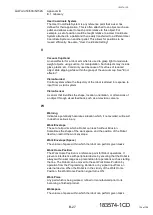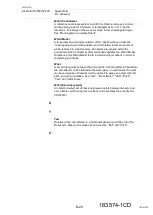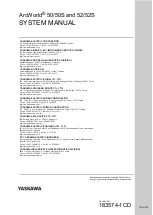
B-18
183574-1CD
183574-1CD
Appendix B
B.1 Glossary
ArcWorld 50/50S/52/52S
Playback Operation
Playback is the operation by which the taught job is played back. This
function is used to decide where to resume the playback on the start
operation after suspending the playback and moving the cursor or
selecting other jobs. 0: Starts operation where the cursor is located in the
job displayed at the moment. 1: The playback continuation window
appears. Select “YES” and the playback resumes where the cursor has
been located when the playback suspended. If “NO” is selected, the
playback resumes where the cursor is located in the job displayed at the
moment. Mode switch on the Programming Pendant: PLAY – job is
started up by [START] on the Programming Pendant and remote job is
started by a peripheral device (external start input).
Point-to-Point
Robot motion in which a limited number of points along a projected path of
motion is specified. The Robot moves from point to point rather than a
continuous smooth path.
Pose
Alternative term for robot configuration, which describes the linear and
angular position. The linear position includes the azimuth, elevation and
range of the object. The angular position includes the roll, pitch and yaw of
the object. See
,
Position
The definition of an object's location in 3D space, usually defined by a 3D
coordinate system using X, Y and Z coordinates.
Position Level
The position level is the degree of approximation of the Robot to a taught
position. The position level can be added to move instructions MOVJ (joint
interpolation) and MOVL (linear interpolation). If the position level is not
set, the precision depends on the operation speed. Setting an appropriate
level moves the Robot in a path suitable to circumferential conditions and
the workpiece.
Position Variables
Position Variables are used in a robot program (JOB) to define a location
in 3D space, usually defined by a 3D coordinate system using X, Y and Z
coordinates. As it is a variable, the value can change depending on
conditions or on information passed to the JOB.
Power and Force Limiting (PFL)
Collaborative feature that allows both the operator and robot to work in
proximity to one another by ensuring the robot will slow down and stop
before a contact situation occurs. In order for this feature to be safely
implemented, functional safety and additional detection hardware must be
used. A risk assessment shall be used determine if any additional
safeguarding is necessary to mitigate risks within the robot system.
Presence-sensing Safeguarding Device
A device designed, constructed and installed to create a sensing field to
detect an intrusion into such field by people, robots or objects. See
115 of 126












































